Shaoshuai Li
Neural Node Matching for Multi-Target Cross Domain Recommendation
Feb 12, 2023



Abstract:Multi-Target Cross Domain Recommendation(CDR) has attracted a surge of interest recently, which intends to improve the recommendation performance in multiple domains (or systems) simultaneously. Most existing multi-target CDR frameworks primarily rely on the existence of the majority of overlapped users across domains. However, general practical CDR scenarios cannot meet the strictly overlapping requirements and only share a small margin of common users across domains}. Additionally, the majority of users have quite a few historical behaviors in such small-overlapping CDR scenarios}. To tackle the aforementioned issues, we propose a simple-yet-effective neural node matching based framework for more general CDR settings, i.e., only (few) partially overlapped users exist across domains and most overlapped as well as non-overlapped users do have sparse interactions. The present framework} mainly contains two modules: (i) intra-to-inter node matching module, and (ii) intra node complementing module. Concretely, the first module conducts intra-knowledge fusion within each domain and subsequent inter-knowledge fusion across domains by fully connected user-user homogeneous graph information aggregating.
* 13pages
Semi-Supervised Heterogeneous Graph Learning with Multi-level Data Augmentation
Nov 30, 2022Abstract:In recent years, semi-supervised graph learning with data augmentation (DA) is currently the most commonly used and best-performing method to enhance model robustness in sparse scenarios with few labeled samples. Differing from homogeneous graph, DA in heterogeneous graph has greater challenges: heterogeneity of information requires DA strategies to effectively handle heterogeneous relations, which considers the information contribution of different types of neighbors and edges to the target nodes. Furthermore, over-squashing of information is caused by the negative curvature that formed by the non-uniformity distribution and strong clustering in complex graph. To address these challenges, this paper presents a novel method named Semi-Supervised Heterogeneous Graph Learning with Multi-level Data Augmentation (HG-MDA). For the problem of heterogeneity of information in DA, node and topology augmentation strategies are proposed for the characteristics of heterogeneous graph. And meta-relation-based attention is applied as one of the indexes for selecting augmented nodes and edges. For the problem of over-squashing of information, triangle based edge adding and removing are designed to alleviate the negative curvature and bring the gain of topology. Finally, the loss function consists of the cross-entropy loss for labeled data and the consistency regularization for unlabeled data. In order to effectively fuse the prediction results of various DA strategies, the sharpening is used. Existing experiments on public datasets, i.e., ACM, DBLP, OGB, and industry dataset MB show that HG-MDA outperforms current SOTA models. Additionly, HG-MDA is applied to user identification in internet finance scenarios, helping the business to add 30% key users, and increase loans and balances by 3.6%, 11.1%, and 9.8%.
HGV4Risk: Hierarchical Global View-guided Sequence Representation Learning for Risk Prediction
Nov 15, 2022Abstract:Risk prediction, as a typical time series modeling problem, is usually achieved by learning trends in markers or historical behavior from sequence data, and has been widely applied in healthcare and finance. In recent years, deep learning models, especially Long Short-Term Memory neural networks (LSTMs), have led to superior performances in such sequence representation learning tasks. Despite that some attention or self-attention based models with time-aware or feature-aware enhanced strategies have achieved better performance compared with other temporal modeling methods, such improvement is limited due to a lack of guidance from global view. To address this issue, we propose a novel end-to-end Hierarchical Global View-guided (HGV) sequence representation learning framework. Specifically, the Global Graph Embedding (GGE) module is proposed to learn sequential clip-aware representations from temporal correlation graph at instance level. Furthermore, following the way of key-query attention, the harmonic $\beta$-attention ($\beta$-Attn) is also developed for making a global trade-off between time-aware decay and observation significance at channel level adaptively. Moreover, the hierarchical representations at both instance level and channel level can be coordinated by the heterogeneous information aggregation under the guidance of global view. Experimental results on a benchmark dataset for healthcare risk prediction, and a real-world industrial scenario for Small and Mid-size Enterprises (SMEs) credit overdue risk prediction in MYBank, Ant Group, have illustrated that the proposed model can achieve competitive prediction performance compared with other known baselines.
Poincaré Heterogeneous Graph Neural Networks for Sequential Recommendation
May 16, 2022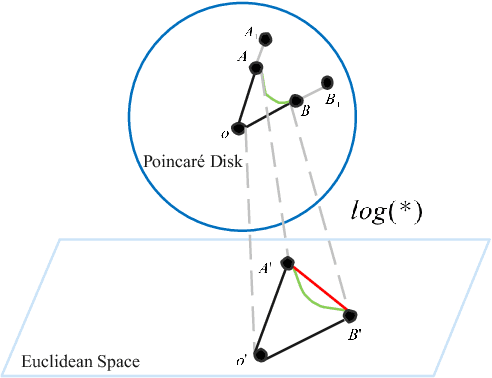
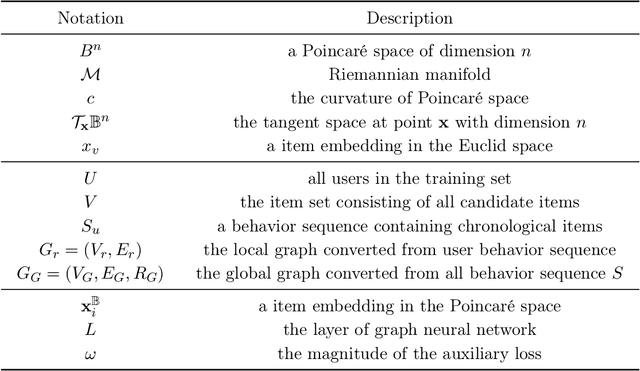
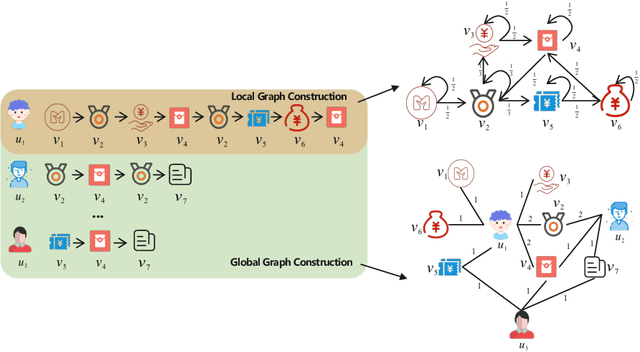

Abstract:Sequential recommendation (SR) learns users' preferences by capturing the sequential patterns from users' behaviors evolution. As discussed in many works, user-item interactions of SR generally present the intrinsic power-law distribution, which can be ascended to hierarchy-like structures. Previous methods usually handle such hierarchical information by making user-item sectionalization empirically under Euclidean space, which may cause distortion of user-item representation in real online scenarios. In this paper, we propose a Poincar\'{e}-based heterogeneous graph neural network named PHGR to model the sequential pattern information as well as hierarchical information contained in the data of SR scenarios simultaneously. Specifically, for the purpose of explicitly capturing the hierarchical information, we first construct a weighted user-item heterogeneous graph by aliening all the user-item interactions to improve the perception domain of each user from a global view. Then the output of the global representation would be used to complement the local directed item-item homogeneous graph convolution. By defining a novel hyperbolic inner product operator, the global and local graph representation learning are directly conducted in Poincar\'{e} ball instead of commonly used projection operation between Poincar\'{e} ball and Euclidean space, which could alleviate the cumulative error issue of general bidirectional translation process. Moreover, for the purpose of explicitly capturing the sequential dependency information, we design two types of temporal attention operations under Poincar\'{e} ball space. Empirical evaluations on datasets from the public and financial industry show that PHGR outperforms several comparison methods.
MHSCNet: A Multimodal Hierarchical Shot-aware Convolutional Network for Video Summarization
Apr 19, 2022



Abstract:Video summarization intends to produce a concise video summary by effectively capturing and combining the most informative parts of the whole content. Existing approaches for video summarization regard the task as a frame-wise keyframe selection problem and generally construct the frame-wise representation by combining the long-range temporal dependency with the unimodal or bimodal information. However, the optimal video summaries need to reflect the most valuable keyframe with its own information, and one with semantic power of the whole content. Thus, it is critical to construct a more powerful and robust frame-wise representation and predict the frame-level importance score in a fair and comprehensive manner. To tackle the above issues, we propose a multimodal hierarchical shot-aware convolutional network, denoted as MHSCNet, to enhance the frame-wise representation via combining the comprehensive available multimodal information. Specifically, we design a hierarchical ShotConv network to incorporate the adaptive shot-aware frame-level representation by considering the short-range and long-range temporal dependency. Based on the learned shot-aware representations, MHSCNet can predict the frame-level importance score in the local and global view of the video. Extensive experiments on two standard video summarization datasets demonstrate that our proposed method consistently outperforms state-of-the-art baselines. Source code will be made publicly available.
HCGR: Hyperbolic Contrastive Graph Representation Learning for Session-based Recommendation
Jul 06, 2021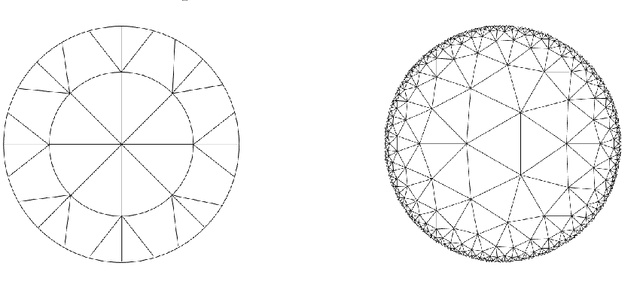
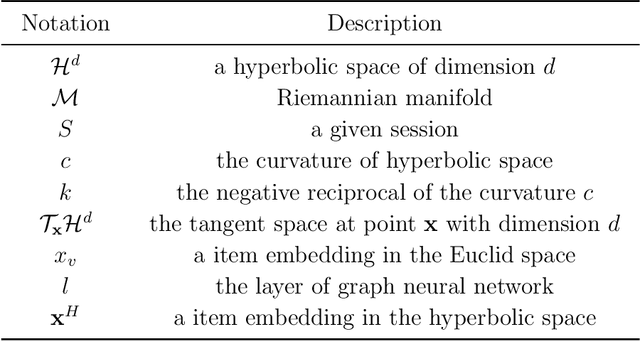


Abstract:Session-based recommendation (SBR) learns users' preferences by capturing the short-term and sequential patterns from the evolution of user behaviors. Among the studies in the SBR field, graph-based approaches are a relatively powerful kind of way, which generally extract item information by message aggregation under Euclidean space. However, such methods can't effectively extract the hierarchical information contained among consecutive items in a session, which is critical to represent users' preferences. In this paper, we present a hyperbolic contrastive graph recommender (HCGR), a principled session-based recommendation framework involving Lorentz hyperbolic space to adequately capture the coherence and hierarchical representations of the items. Within this framework, we design a novel adaptive hyperbolic attention computation to aggregate the graph message of each user's preference in a session-based behavior sequence. In addition, contrastive learning is leveraged to optimize the item representation by considering the geodesic distance between positive and negative samples in hyperbolic space. Extensive experiments on four real-world datasets demonstrate that HCGR consistently outperforms state-of-the-art baselines by 0.43$\%$-28.84$\%$ in terms of $HitRate$, $NDCG$ and $MRR$.
 Add to Chrome
Add to Chrome Add to Firefox
Add to Firefox Add to Edge
Add to Edge